« Africa Photos - 11 | Main | Africa Photos - 12 »
April 22, 2007
Wild about Wildlife
Another section of this trip is over, just one more to go on this epic 'Dover to Cape Town' adventure. And an adventure it is really turning out to be, as we explore further down this vast continent. The last section was quite different from anything we have encountered so far. Sure, we'd seen Game Parks, but nothing on the scale of the Serengeti, which just goes on and on, over seemingly limitless grasslands, rivers and forest. The number of animals, too, have been quite staggering. We were lucky enough to see the start of the annual migration when vast herds of zebra and wildebeeste trek south towards better grazing - something I've wanted to see every since it was mentioned by John Cleese in episode 7 of the classic 'Fawlty Towers:
Mrs. Richards: [standing next to the window] And another thing: I asked for aroom with a view.
Basil Fawlty: [aside to Manuel] Deaf, mad, *and* blind.
[to Mrs. Richards as he makes a show of inspecting the view]
Basil Fawlty: This is the view as far as I can remember... Yes... Yes, this is it.
Mrs. Richards: When I pay for a view, I expect to see something more interesting than that.
Basil Fawlty: That is Torquay, madam.
Mrs. Richards: Well, that's not good enough.
Basil Fawlty: Well, might I ask what you expected to see out of a Torquay hotel bedroom window? Sydney Opera House, perhaps? The hanging gardens of Babylon? Herds of wildebeest sweeping majestically...
Basil at his sarcastic best. Wonderful stuff.
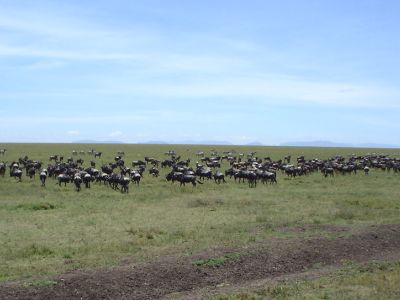
Wildebeeste on the Plains
Back to those wildebeeste - yes there really were herds of them. Huge herds. Vast herds. My camera has a rather wide angle lens, so I wasn't able to take any closeups of the huge numbers ranging into the distance - they would have just been a blur on the screen. The zebra are there in huge numbers too - how do they all know when to meet up, and where? Who decides when to start? Zebras are great fun to watch, and I was very glad that I'd brought a pair of 10x50 binoculars with me - I may not be able to record the moment, but at least I enjoyed watching it. Here's a neat trick, thought up by Tom - sometimes by combining camera and binoculars together a passable photo results - see the one of the lioness, or the one of the leopard, on the previous photo-pages. OK so its not as good as its equivalent 500mm lens (when I win the LOTTO haha), but at least it shows something, and is worth experimenting with.
In case you are wondering what a Whistling Thorn Tree is, take a look at this link. These trees are very common in the Serengeti, and have an infestation of ants that produces many bulbous swellings about 1 inch in diameter, similar to the Oak Apple on our own Common Oak tree in England. These swellings are home to four different kinds of stinging ants who pierce these swollen thorns with tiny holes - something I found out for myself by tapping on the side of one, and seeing the many ants who rushed out to see what the matter was. What about the whistling? - well, when the wind blows it turns old and abandoned swollen spines into tiny whistling flutes, which gives the tree its name. Noisy trees - does Africa have no end to its wonders?
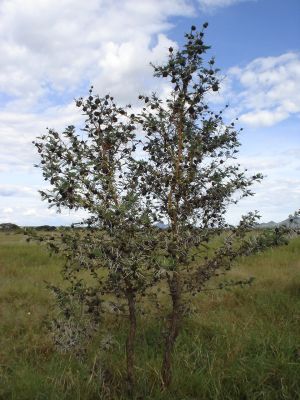
Whistling Thorn Tree
We spent a short time at the famous Lake Victoria, and I had the regulation paddle, despite bilharzia and whatever. It gave me a queer feeling to think that the water I was paddling in would eventually make its way down the River Nile, past the countryside of Sudan and Egypt through which I'd been travelling, across Lake Nasser, past the marvels of Abu Simbel and Luxor, past all the Papyrus and the Sacred Ibis, past the pyramids at Giza, and into the Mediterranean, that heart of civilisation, and somewhere I might like to put roots down myself one of these days.
Onto another wildlife haven and wildlife heaven: Ngorogoro Crater. As its name suggests, it is a huge - actually the world's largest - unbroken volcanic crater; to be technically correct its a caldera - the mountainous rim of a now-extinct volcano. The crater is 610m deep and the floor is 260km². The steep sides of the crater, the presence of water, and the abundance of rich volcanic soil mean that it has become a natural enclosure for a very wide variety of wildlife, including most of the species found in East Africa.
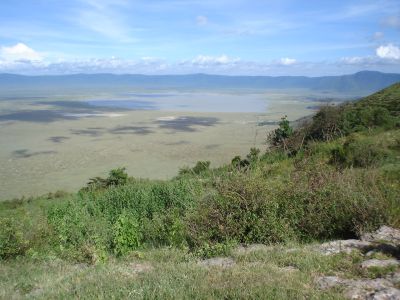
Ngorogoro Crater
Aside from herds of zebra, gazelle and wildebeest, there are numbers of rhinoceros, lion, leopard, elephant and buffalo, as well as warthog, duiker, hyena and many more. We travelled into the crater in open-top Land Cruisers, as the sides of the crater are too steep for the Dragoman truck to cope with. Arriving early in the morning, we saw many different animals, birds, and plants. Although no carnivores were spotted that day, we saw the, for me, just as impressive elephants, which we were able to get quite close to, and in some cases too close to, as you can see from my photographs. Remember that I am using a wide-angle lens - wow how cool is that?!?!
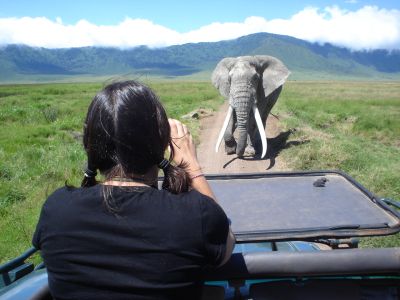
Photographing Elephants
Passing the mighty Mount Kilmanjaro -(no time to do the high-altitude climb this time - oh dear what a pity never mind)- we made our way through Tanzania, and down to the coastal city of Dar Es Salaam, which is the entry point for one of the highlights - for me - of this trip, a visit to the spice island of Zanzibar. We hit it in the middle of the rainy season, in case you were wondering why some of the photos are rather grey, but even in the rainy season there are breaks of good weather, and after the first day or so we were lucky to get one, so the rest of the stay was very sunny, if EXTREMELY humid with it, something you can't show on a photo.
I found Stone Town, a living, vibrant town that is also a World Heritage site, to be absolutely fascinating, and I was very glad that I spent more time there than on the white beaches, for which Zanzibar is also most famous. It was very interesting to wander around the myriad of twisting alleys, and imagine the lives of the African, Arab, and Indian communities who have lived there for centuries, trading in slaves, ivory, cloves, and mangrove logs. The island was ideally placed to take advantage of Arab dhows travelling east and west across the Indian Ocean on the bi-annual monsoons. If you ever go there, be sure to visit the National Museum, which explains and illustrates this in great detail. Check out the shops as well, and you too can be the proud owner of a shirt as amazing as this one...

Tims Shirt and Haircut
The haircut - well yes, its a little shorter than I normally have. I went into a barber's shop in Stone Town, and asked for 'short'. He turned on his high-speed electric clippers, and before I could say anything, had already shaved one strip of my head down to the roots! I then managed to call a halt, and got him to increase the rest to a generous 2mm. The result you can see. After some reflection, I have decided that I quite like it. What do you think?
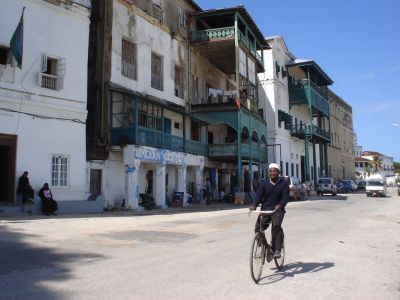
Stone Town Waterfront
Back to the mainland, and into Malawi, where we spent a while travelling through the mountainous countryside, and some time on the shores of beautiful Lake Malawi, which, surprisingly, has constant and quite large waves. Lilongwe, the capital, was visited briefly, and then we entered Zambia, to see the magnificent Kariba Dam, and spend an excellent few days travelling by open canoe down the Zambesi River, dodging the numerous hippos that hide beneath the water, and crocodiles who lurk beside it. Just in case you think that the Hippopotamus is the less deadly of the two - well we've all seen them dancing in 'Fantasia' haven't we - think again - they have to be given a wide berth, and treated with real caution. A tourist on another of the Overland trucks at Lake Naivasha was killed by one quite recently.
Unfortunately, I didn't take my camera along with me on our Zambesi canoe journey - the chance of capsizing and losing it was just too great a risk, so you'll have to look elsewhere for photos.
At the border of Zambia and Zimbabwe is the mighty Victoria Falls, known by the locals as 'The Smoke That Thunders'. An apt name indeed, as here in the town of Victoria Falls its noise can be heard all the time. The photos on my pages only show the views from the Zambian side, accessed from the town of Livingstone. The large bridge in the photo is the border between the two countries. I have still to visit the falls from the Zimbabwean side, so will add them later.
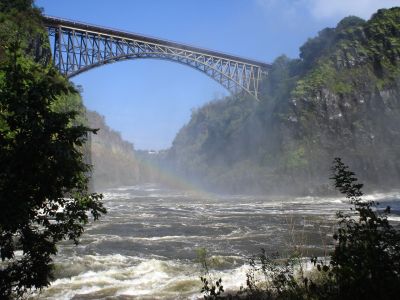
The Bridge from Zam to Zim
Forgot to mention about the current truck occupants. In Victoria Falls we said goodbye to Tom, who is going south on a Nomad truck. We have gained 3 new passengers though, so now the total pax is 7. The new members are Cliff, 55, from the US, and Laura 21 and Steve 30, both from New Zealand.
One thing that I have done here is to check at the Post Restante counter to see if there was any mail waiting for me. This time yes (whoopee again) - there were 2 letters, from Dennis Searle and Jill Monagahan. 1 more arrived on Monday 23/4/07, from Margaret Makins. It had taken since the 5th to get here!
If you would like to send me a letter to one of the future mail-stops, (all most welcome) go to this page for the next address, which is Cape Town, in South Africa.
Posted by travellingtim at April 22, 2007 06:42 PM
